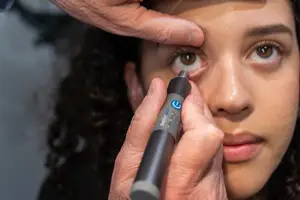Dry Eye Treatment in Athens, GA
Our Dry Eye Clinic is led by Dr. Kaj Vetha, who brings advanced training and a compassionate, investigative approach to identifying what’s truly causing your discomfort.


When Your Eyes Feel Dry, Gritty, or Tired
Dry eye disease is one of the most common and frustrating eye conditions, affecting comfort and clarity. It can make reading difficult, screen time uncomfortable, and day-to-day life more irritating than it needs to be. If you’ve tried over-the-counter drops with little relief, there’s likely more going on beneath the surface.
We take a full-scope approach to dry eye care in Athens. That means understanding the cause, not just treating the symptoms and building a care plan that actually works for you.
What Causes Dry Eye?
Dry eye can happen when your eyes don’t produce enough tears, or when the tears you produce don’t have the right balance of oil, water, and mucus. Some common causes include:
Meibomian gland dysfunction (MGD)
Age-related changes
Hormonal shifts (especially postmenopausal)
Screen time and reduced blinking
Contact lens wear
Environmental factors (like wind, heat, or dry air)
Certain medications or medical conditions
The good news is that there are effective ways to treat dry eye, especially when treatment is based on the right diagnosis.

How We Diagnose Dry Eye
Our dry eye clinic uses advanced diagnostic tools to evaluate tear production and gland function:
TearLab® Osmolarity Testing to assess tear film stability
Oculus Keratograph for meibomian gland imaging
Slit lamp evaluation to observe inflammation and tear breakup time
This helps us understand what kind of dry eye you have and build a treatment plan that matches your needs no guesswork, no one-size-fits-all approach.
In-Office Treatments for Long-Term Relief
We offer effective, non-surgical treatments that address the root causes of dry eye discomfort:
iLux®
A comfortable, in-office procedure that warms and gently clears blocked meibomian glands. This helps restore the natural oils that keep your tears from evaporating too quickly.
BlephEx®
A gentle exfoliation treatment that removes biofilm and debris from your eyelids and lash line, often a key contributor to inflammation and dry eye symptoms.
We also offer a curated selection of dry eye products, including eye-safe heat masks, lubricating drops, and clinically backed supplements.
These procedures are performed right here in our clinic and are often combined with at-home support, such as heat masks, artificial tears, and nutrition-based recommendations.

Tried Drops With No Relief? You’re Not Alone
Many patients come to us after months (or years) of trying over-the-counter drops that only provide temporary relief. That’s because artificial tears treat symptoms, not the cause. If your dry eye is because of gland dysfunction, inflammation, or tear instability, drops alone won’t solve the problem.
We take the time to get to the root of it and walk you through what to expect, what’s realistic, and how we can help you feel better long term.
Find Comfort That Lasts
If your eyes feel dry, gritty, watery, or constantly irritated, you don’t have to live with it. Dry eye is treatable especially when care is personalized and focused on what works for you. We proudly patients in Athens, Watkinsville, Jefferson, and surrounding areas.
